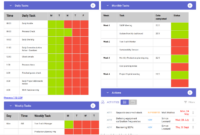Online leadership MA is the art of leading and managing teams and organizations in a virtual environment. It requires a unique set of skills and competencies, and presents both challenges and opportunities for leaders.
In this guide, we will explore the essential skills for online leaders, strategies for building and managing high-performing online teams, and best practices for overcoming the challenges of virtual leadership.
Definition and Overview of Online Leadership
Online leadership involves guiding and influencing individuals and teams in a virtual environment, where communication and collaboration primarily occur through digital platforms. It differs from traditional leadership in that it requires leaders to adapt their communication and management styles to suit the unique challenges and opportunities of virtual work.
Unique Challenges of Online Leadership
- Lack of physical presence:Online leaders cannot rely on physical cues or body language to convey messages or build rapport.
- Communication barriers:Virtual communication can lead to misunderstandings due to the absence of non-verbal cues and the potential for delays or technical glitches.
- Isolation and disengagement:Remote work can create feelings of isolation and disengagement, making it challenging for leaders to maintain team cohesion.
Unique Opportunities of Online Leadership
- Flexibility and accessibility:Online leadership allows for greater flexibility in work arrangements and accessibility to talent from diverse geographical locations.
- Enhanced communication tools:Virtual platforms provide a range of tools for communication and collaboration, such as video conferencing, instant messaging, and project management software.
- Data-driven decision-making:Online environments generate vast amounts of data that can be leveraged for data-driven decision-making and performance tracking.
Essential Skills for Online Leaders
Effective online leadership demands a unique set of skills that enable leaders to navigate the challenges and leverage the opportunities of virtual environments. These include communication, collaboration, and emotional intelligence.Communication is the cornerstone of online leadership. Leaders must convey their vision, engage their teams, and foster a sense of community despite physical distance.
They need to be adept at using a variety of communication channels, from written messages to video conferencing, and be able to adapt their style to different audiences.Collaboration is another essential skill for online leaders. Virtual teams often operate across different time zones and cultures, requiring leaders to facilitate effective collaboration and build a cohesive team.
They must be able to create a shared understanding of goals, foster trust and respect, and resolve conflicts constructively.Emotional intelligence is crucial for online leaders. They need to be self-aware, empathetic, and able to manage their own emotions as well as those of their team members.
In virtual environments, where non-verbal cues are limited, leaders must be able to convey empathy and support through their words and actions.
Building and Managing Online Teams
Building and managing online teams requires a unique set of skills and strategies to foster collaboration and productivity in a virtual environment. Effective online leaders leverage technology, communication tools, and team-building activities to create cohesive and high-performing teams.
Strategies for Building High-Performing Online Teams
- Establish Clear Goals and Expectations:Define team objectives, roles, and responsibilities clearly to ensure alignment and accountability.
- Foster Open Communication:Encourage regular communication through virtual meetings, instant messaging, and discussion forums to facilitate information sharing and idea exchange.
- Utilize Virtual Collaboration Tools:Implement project management software, video conferencing platforms, and shared workspaces to streamline collaboration and knowledge sharing.
- Promote Team Building:Organize virtual team-building activities such as online games, virtual coffee breaks, or online workshops to build camaraderie and trust.
Performance Management in Online Teams
- Set Clear Performance Metrics:Establish measurable performance indicators to track progress and provide feedback.
- Provide Regular Feedback:Offer constructive feedback to team members on their performance, both positive and negative, to support growth and development.
- Utilize Performance Management Tools:Implement online performance management systems to streamline the performance review process and provide automated feedback.
- Encourage Self-Assessment:Encourage team members to self-assess their performance and identify areas for improvement.
Fostering Collaboration and Innovation

Online leadership plays a crucial role in fostering collaboration and innovation within virtual teams. By leveraging technology and promoting a culture of open communication, online leaders can create an environment where team members feel comfortable sharing ideas, taking risks, and working together to achieve shared goals.
One of the key ways that online leaders foster collaboration is through the use of online brainstorming tools. These tools allow team members to generate and share ideas in a virtual space, regardless of their location or time zone. By providing a structured and collaborative environment, online brainstorming tools can help teams to come up with more creative and innovative solutions to problems.
Knowledge-Sharing Platforms
Knowledge-sharing platforms are another important tool for fostering collaboration and innovation within virtual teams. These platforms allow team members to share their expertise and knowledge with each other, regardless of their location or time zone. By creating a central repository for knowledge, online leaders can help team members to learn from each other and to develop new ideas.
Aspiring leaders can take advantage of online leadership MA programs to enhance their skills and knowledge. These programs offer a convenient and flexible way to learn about leadership principles and practices. If you’re looking for the latest news and updates on leadership development, be sure to check out the American Leadership Academy news.
They provide valuable insights and resources for aspiring leaders. By staying up-to-date with the latest trends and best practices, you can effectively navigate the challenges of modern leadership.
Virtual Workspaces
Virtual workspaces are another important tool for fostering collaboration and innovation within virtual teams. These workspaces provide a central location for team members to work on projects together, regardless of their location or time zone. By providing a shared space for collaboration, online leaders can help team members to stay organized and to work together more efficiently.
Overcoming Challenges in Online Leadership

Leading a team in a virtual environment presents unique challenges that online leaders must navigate effectively. These challenges can hinder team performance and overall project success. By understanding these challenges and implementing effective strategies, online leaders can overcome them and foster a thriving and productive team.
Building Trust
In a virtual environment, it can be challenging to establish and maintain trust among team members. Nonverbal cues and spontaneous interactions that are present in face-to-face settings are absent, making it difficult to build rapport and create a sense of camaraderie.
- Establish Clear Communication Channels:Set up multiple communication channels (e.g., video conferencing, instant messaging, email) and encourage their regular use.
- Foster Open and Honest Communication:Encourage team members to share their thoughts, ideas, and concerns openly. Create a safe and supportive environment where they feel comfortable expressing themselves.
- Recognize and Reward Contributions:Acknowledge and appreciate the efforts and contributions of team members, both big and small. This helps build trust and motivates individuals to continue performing at their best.
Overcoming Communication Barriers, Online leadership ma
Virtual communication can be hindered by technical issues, language barriers, and cultural differences. These barriers can lead to misunderstandings, misinterpretations, and decreased team productivity.
- Use Clear and Concise Language:Avoid jargon and technical terms that may not be understood by all team members. Use simple and direct language to ensure clarity.
- Utilize Visual Aids and Examples:Incorporate visual aids (e.g., diagrams, charts, screenshots) to support verbal communication and enhance understanding.
- Establish Communication Protocols:Set clear guidelines for communication, including response times, expected tone, and the appropriate use of different channels.
Maintaining Team Cohesion
In a virtual environment, it can be challenging to maintain team cohesion and a sense of belonging. Team members may feel isolated and disconnected from their colleagues, which can impact their motivation and commitment.
- Organize Virtual Social Events:Host regular online gatherings (e.g., virtual coffee breaks, team-building activities) to foster camaraderie and build relationships.
- Encourage Team Collaboration:Create opportunities for team members to collaborate on projects and share their expertise. This helps build connections and a sense of shared purpose.
- Provide Recognition and Support:Acknowledge and celebrate team successes. Offer support and encouragement to team members when they face challenges.
Best Practices for Online Leadership: Online Leadership Ma

Online leadership requires a unique set of skills and strategies to effectively manage and motivate teams in a virtual environment. Successful online leaders have developed and implemented best practices that foster collaboration, innovation, and team success.
The following table showcases some of the best practices and case studies of effective online leaders:
| Leadership Style | Strategies | Outcomes |
|---|---|---|
| Transformational Leadership |
|
|
| Servant Leadership |
|
|
| Collaborative Leadership |
|
|
The Future of Online Leadership

The future of online leadership is bright, with emerging trends and innovations set to shape the way virtual teams are managed. Artificial intelligence (AI) and virtual reality (VR) are among the technologies poised to transform online leadership, enabling leaders to connect with their teams in new and immersive ways.
Artificial Intelligence (AI)
AI-powered tools can assist online leaders in various aspects of team management, such as:
- Automating repetitive tasks, freeing up leaders to focus on strategic initiatives.
- Providing real-time insights into team performance and engagement.
- Facilitating personalized learning and development opportunities for team members.
Virtual Reality (VR)
VR technology can create immersive virtual environments where online teams can collaborate and interact as if they were physically present in the same space. This can enhance team cohesion, communication, and innovation.
- Virtual meetings and workshops can be held in VR, allowing for more engaging and interactive experiences.
- VR simulations can be used to train team members on new skills and procedures.
- Virtual team-building activities can foster camaraderie and trust among team members.
These emerging technologies hold immense potential to revolutionize online leadership and empower leaders to manage virtual teams more effectively and efficiently in the future.
Final Thoughts

Online leadership is a rapidly evolving field, and the future holds many exciting possibilities. As technology continues to advance, we can expect to see new and innovative ways to lead and manage virtual teams.
If you are interested in a career in online leadership, there are many resources available to help you get started. With the right skills and knowledge, you can be a successful leader in the virtual world.
Answers to Common Questions
What are the key skills for online leaders?
The key skills for online leaders include communication, collaboration, emotional intelligence, and technical proficiency.
What are the challenges of online leadership?
The challenges of online leadership include building trust, overcoming communication barriers, and maintaining team cohesion.
What are the best practices for online leadership?
The best practices for online leadership include setting clear expectations, communicating frequently, and providing regular feedback.





